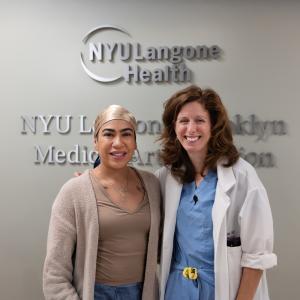Personal Trainer Grateful to NYU Langone Neurosurgeon for Getting Her Life Back on Track
Normally, Diana Lipari would push through the pain as she went about her day, but when a splitting headache hit her last summer she knew this was different.
“I had horrible pain in the back of my neck for about a week and I was not feeling right at all,” says Lipari, a 36-year-old Brooklyn native and former school teacher. “The pain was waking me up throughout the night.”
Her situation grew dire when she became completely immobile during a tutoring session. “All of the sudden I couldn’t move,” she recalls.
She was rushed to the Emergency Department at NYU Langone Hospital—Brooklyn, where a series of radiological exams revealed the source of her paralysis: a two-inch mass on her brain at the base of her skull.
“A tumor was exerting significant pressure on her brainstem,” says David S. Gordon, MD, director of cranial, vascular, and skull-base neurosurgery at NYU Langone Hospital—Brooklyn. “The skull has fixed volume. Anything introduced into the intracranial space, like a tumor, results in an increase in pressure and displacement of normal structures that control the transmission of nerve impulses.”
In the back of the brain—where Lipari’s tumor was—the brainstem functions like a “control center,” where all information going from the brain to the body and from the body to the brain passes through.
The growth was situated in a particular region of the brain called the cerebellum, which controls balance and coordination of motor function. For Lipari, who had just started working toward personal training certification, the tumor not only threatened her new career path—but her life as well.
Dr. Gordon performed on Lipari a neurosurgical procedure known as a suboccipital craniectomy with frameless stereotactic navigation to remove the mass. It involves a computer guidance system that allowed Dr. Gordon to see a complete picture of Lipari’s brain during surgery and to monitor the movement of his instruments inside the skull. The technology enhances precision, allowing a surgeon to make a smaller opening to the brain and providing a greater margin of safety for the patient.
A year later, Lipari is back training hard at the gym—and finishing up her certification. “I’m doing great,” she says. “Dr. Gordon saved my life. I’ll never, ever take one moment for granted.”
Dr. Gordon continues to see Lipari regularly. “Thankfully, the mass was noncancerous, which is the best outcome you could hope for,” says Dr. Gordon. “We’ll follow her over the course of several years with regular imaging to ensure continued good health.”
Dr. Gordon collaborates closely with colleagues throughout NYU Langone Health. With access to a wide array of resources, technology, and clinical talent, the Department of Neurosurgery and NYU Langone’s Brain Tumor Center—part of Perlmutter Cancer Center—are equipped to treat any neuro-oncologic and cerebrovascular condition.
“This is an example of what we want to do every day for our patients,” says John G. Golfinos, MD, co-director of the Brain Tumor Center and chair of NYU Langone Health’s Department of Neurosurgery. “We have the best neurosurgeons in the field and our goal is always to improve the lives of our patients while prioritizing their safety.”

